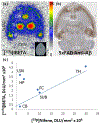Abnormal [18 F]NIFENE binding in transgenic 5xFAD mouse model of Alzheimer's disease: In vivo PET/CT imaging studies of α4β2* nicotinic acetylcholinergic receptors and in vitro correlations with Aβ plaques
- PMID: 36749986
- PMCID: PMC10148164
- DOI: 10.1002/syn.22265
Abnormal [18 F]NIFENE binding in transgenic 5xFAD mouse model of Alzheimer's disease: In vivo PET/CT imaging studies of α4β2* nicotinic acetylcholinergic receptors and in vitro correlations with Aβ plaques
Abstract
Since cholinergic dysfunction has been implicated in Alzheimer's disease (AD), the effects of Aβ plaques on nicotinic acetylcholine receptors (nAChRs) α4β2* subtype were studied using the transgenic 5xFAD mouse model of AD. Using the PET radiotracer [18 F]nifene for α4β2* nAChRs, in vitro autoradiography and in vivo PET/CT studies in 5xFAD mice were carried out and compared with wild-type (C57BL/6) mice. Ratios of [18 F]nifene binding in brain regions versus cerebellum (CB) in 5xFAD mice brains were for thalamus (TH) = 17, hippocampus-subiculum = 7, frontal cortex (FC) = 5.5, and striatum = 4.7. [125 I]IBETA and immunohistochemistry (IHC) in 5xFAD brain slices confirmed Aβ plaques. Nicotine and acetylcholine displaced [18 F]nifene in 5xFAD mice (IC50 nicotine = 31-73 nM; ACh = 38-83 nM) and C57BL/6 (IC50 nicotine = 16-18 nM; ACh = 34-55 nM). Average [18 F]nifene SUVR (CB as reference) in 5xFAD mice was significantly higher in FC = 3.04 compared to C57BL/6 mice FC = 1.92 (p = .001), whereas TH difference between 5xFAD mice (SUVR = 2.58) and C57BL/6 mice (SUVR = 2.38) was not significant. Nicotine-induced dissociation half life (t1/2 ) of [18 F]nifene for TH were 37 min for 5xFAD mice and 26 min for C57BL/6 mice. Dissociation half life for FC in C57BL/6 mice was 77 min , while no dissociation of [18 F]nifene occurred in the medial prefrontal cortex (mFC) of 5xFAD mice. Coregistration of [18 F]nifene PET with MR suggested that the mPFC, and anterior cingulate (AC) regions exhibited high uptake in 5xFAD mice compared to C57BL/6 mice. Ex vivo [18 F]nifene and in vitro [125 I]IBETA Aβ plaque autoradiography after in vivo PET/CT scan of 5xFAD mouse brain were moderately correlated (r2 = 0.68). In conclusion, 5xFAD mice showed increased non-displaceable [18 F]nifene binding in mPFC.
Keywords: 5xFAD transgenic mice; Alzheimer's disease; PET/CT; [125I]IBETA; [18F]FEPPA; [18F]Nifene.
© 2023 The Authors. Synapse published by Wiley Periodicals LLC.
Conflict of interest statement
CONFLICT OF INTEREST STATEMENT
The authors declare no conflict of interest.
Figures











References
-
- Braak H, Thal DR, Ghebremedhin E, & Del Tredici K (2011). Stages of the pathologic process in Alzheimer disease: Age categories from 1 to 100 years. Journal of Neuropath & Experimental Neurology, 70(11), 960–969. - PubMed
Publication types
MeSH terms
Substances
Grants and funding
LinkOut - more resources
Full Text Sources
Medical
Molecular Biology Databases
